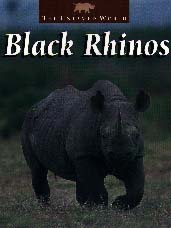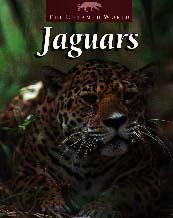

 Black Rhinos E. Melanie Watt. Illustrated by Warren Clark.
Subject Heading:
Grades 3 - 8 / Ages 8 - 13.
**** /4
|
 Jaguars. E. Melanie Watt. Illustrated by Warren Clark.
Subject Heading:
Grades 3 - 8 / Ages 8 - 13.
**** /4
|

excerpt:
There are usually two main seasons in jaguar habitats: the rainy season and the dry season. In the rainy season, areas of a jaguar's territory may not be usable because of flooding. This means that many jaguars have much smaller territories during the rainy season. The jaguar's prey is also often crowded into these smaller areas in this time of year. This makes them easier to find. Jaguar eating habits change throughout the year. Some foods, such as turtle or iguana eggs, are available only in one season. Some of the jaguar's prey may be easier to catch in a particular season. For example, during sea turtle nesting seasons, the turtles are easy to catch when they climb out of the water to lay their eggs on the beach. Many prey species tend to have young in one season and not in the other. Some jaguar prey may also be easier to catch when they are protecting their young. For larger prey, jaguars may even prefer hunting the young.The titles in "The Untamed World" series are excellent. Each book is packed with full colour photographs and clear, readable text, and includes a glossary, index, and a "20 fascinating facts" section. A page on "viewpoints" presents the pros and cons of a controversial question. The "Folklore" section in each book describes the animal's place in folk tales and legend, while "What you can do" gives addresses of conservation organizations.
A map illustrates the range and distribution of the animal. In Black Rhinos, the different species of rhinos are described and pictured, while the special adaptations of the rhino's body parts and senses are explained. The attention to detail in this series is truly remarkable.
The contents page of Black Rhinos provides an indication of the scope of the contents found in the titles of this series: Introduction, Features, The crash [a group of rhinos is called a crash], Rhino calves, Habitat, Food, Competition, Folklore, Status, Twenty Fascinating Facts, Glossary, Suggested Reading, Index. The credentials of the consultants listed are impressive, and the photographs are credited to such institutions as the U.S. Fish and Wildlife Service and the Corel Corporation.
Highly recommended.
Luella Sumner is Head Librarian, Red Rock Public Library, in Red Rock, Ontario.

To comment on this title or this review, send mail to cm@umanitoba.ca.
Copyright © 1998 the Manitoba Library Association. Reproduction for personal use is permitted only if this copyright notice is maintained. Any other reproduction is prohibited without permission.
Published by
The Manitoba Library Association
ISSN 1201-9364
TABLE OF CONTENTS FOR THIS ISSUE - FEBRUARY 13, 1998.
AUTHORS | TITLES | MEDIA REVIEWS | BOOKSHELF | BACK ISSUES | SEARCH | CMARCHIVE | HOME